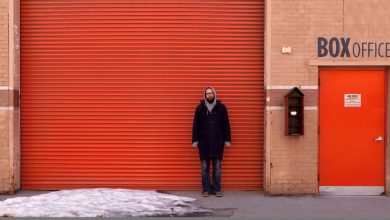A Ballerina Harnesses Her Wild Imagination to Choreography

When Benjamin Millepied suggested three years ago that Janie Taylor try her hand at choreography for his company, the L.A. Dance Project, she had an immediate response: “That’s crazy,” she told him.
But on Tuesday, the L.A. Dance Project will present two pieces by Taylor, a former principal at New York City Ballet, as part of its two-week season at the Joyce Theater, with two programs focusing on female dance makers. Both Taylor works — “Adagio in B Minor,” a pas de deux; and “Night Bloom,” an ensemble piece — are on the first program, alongside Bella Lewitzky’s rarely seen 1970 “Kinaesonata” and Madeline Hollander’s “5 Live Calibrations.” (“Night Bloom” is also on the second program, alongside Bobbi Jene Smith and Or Schraiber’s “Solo at Dusk.”)
Taylor, 41, who left City Ballet in 2014, was a distinctive presence onstage. With her exceptionally pale skin, waist-length blond hair and febrile intensity, she stood out in roles like the doomed Romantic heroines of George Balanchine’s “La Sonnambula,” and “La Valse,” and the artless young woman in Jerome Robbins’s “Afternoon of a Faun.” Her dancing, Jennifer Dunning wrote in The New York Times, is a “smooth reconciliation of opposites: recklessness and serenity, bold incisiveness and dreaming amplitude.”
These are qualities that Taylor has brought to her new role as a choreographer.
“As a dancer, Janie had that quality of being extreme and looking like it was all made up on the spot,” said Millepied, also a former principal at City Ballet. “And she has a wild imagination and was always a creative person, always making things, working on personal projects that were very much part of her personal aesthetic. It was pretty clear to me: There was no reason she couldn’t make a ballet.”
Taylor made a comeback as a dancer in 2016 with the L.A. Dance Project, where her husband, Sebastien Marcovici, another former City Ballet dancer, is the rehearsal director. At the Joyce, she will dance in “Solo at Dusk.”
“I’m not saying it’s my last performance, because clearly last time that didn’t stick,” she said in a video interview from her home in Los Angeles, where she lives with Marcovici and their 6-month-old son. Sitting outside in the sun, she talked about why she left City Ballet, starting to dance again and whether she felt like a choreographer.
Here are edited excerpts from the conversation.
Do you think you have a choreographic style? “Night Bloom” is very balletic, even Balanchinian at times, but looser and more unstructured at others.
That work is set to Stravinsky, and I was definitely making a nod to Balanchine and where I come from, dance-wise. Also, I wanted to give the L.A.D.P. dancers some ballet to do onstage because they are actually really good ballet dancers.
For me, choreography is a kind of compilation of my favorite things; it could be a tight fifth position, or it could be collapsing to the floor with zero technique or form. And it could be images from life or from fantasy.
Has working with choreographers at L.A. Dance Project influenced you?
Having so many contemporary choreographers come in really opened my eyes. You realize, oh, this is dance and this is dance, and all these ways of finding and coming up with movement are valid, and a means of making your own voice and language new. It seems important and interesting not to get stuck doing the same thing.
You left City Ballet relatively early in your career. Why?
I had an amazing time there. But I felt if I stayed another five years, it would probably be pretty similar in terms of roles, and I had quite a lot of injuries. I suppose I might have hung in longer if Sebastien, who is five years older than me, hadn’t been wrapping things up. He had a bad foot injury, and Ben asked if we wanted to join him in L.A. We also knew, although it hadn’t been announced, that Ben had the Paris Opera Ballet job and that we would go with him, so that was exciting. [Millepied ran the Paris Opera Ballet for almost two years, from 2014 to 2016.]
Sebastien was a ballet master at the Opera, and I staged several ballets in Europe, for Justin Peck and Benjamin, which I loved. But although I love Paris, living there was hard. When Ben left to go back to L.A., we were ready to go, too.
How did you start dancing again?
Toward the end at City Ballet, I was always worrying about injuries, and it made dancing much less fun. But when I was setting Justin or Ben’s work on companies, I could just dance without worrying about it. I was teaching the men’s parts, too, and showing those steps, and I felt, wow, I am dancing better than I was at the end of my City Ballet time.
Then Ben made a little duet for the two of us to perform at a company gala. Neither of us had danced onstage for ages, and it was really fun. I thought, OK, maybe I can dance a bit more. It was a chance to learn and experience more techniques and styles.
And you never thought about choreography?
It never occurred to me! In the early stages of my career at City Ballet, I had complete tunnel vision about dancing, and I wasn’t looking for anything different.
After I started dancing again, at L.A.D.P., Benjamin made “I Fall, I Flow, I Melt,” and asked some of us to generate some movement material. At City Ballet, no one ever asked us to do that, so it was a new experience. I think he saw something in what I did. He suggested the short Mozart “Adagio in B Minor,” and that I work with David Adrian Freeland, who I had danced with a lot.
I was doubtful, but thought I’ll give it two days, and maybe I’ll hate it, or maybe I’ll make something and it will be terrible, or maybe I will like it. I have spent a lot of time with different choreographers, all with different processes, so I also told myself: There are no rules.
For years now, I have been making little stop-motion films. You create an environment and plan the movement, and set it to some music. I realized this is just on a bigger scale, with people.
These programs at the Joyce show almost exclusively female choreographers. Are things changing in the dance world?
I definitely see a change. Companies are seeking out women. And I see a lot of very young women making work. I think that a new generation sees things differently and has more confidence about what they can do than I did. But perhaps that’s just my personality.
You also design costumes, but described that as more of a hobby. What about choreography?
I have definitely decided I am going forward on this path. As I stop dancing, or dance less, it has given me the fulfillment of the physicality of dancing without having to be the one onstage. I realize that I really like creating a whole world. I like it as a dancer, as a costume designer, as a choreographer. I’m making my way around it all.





